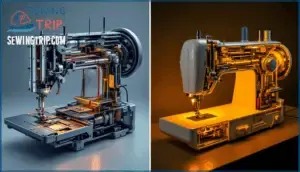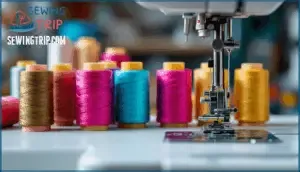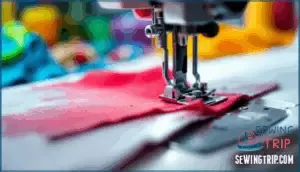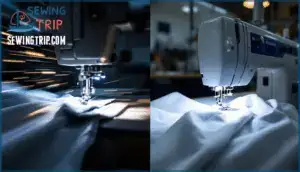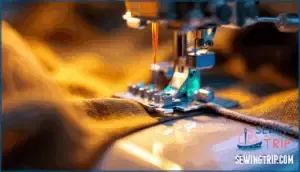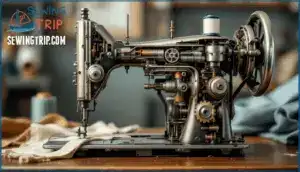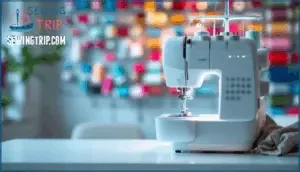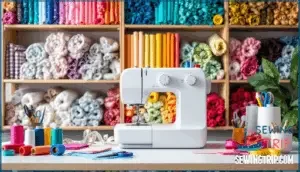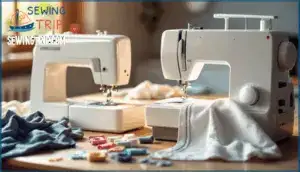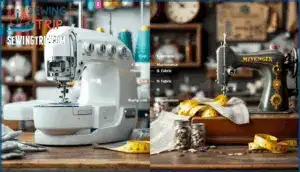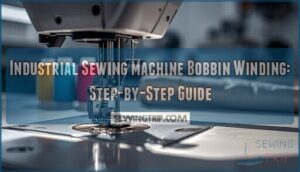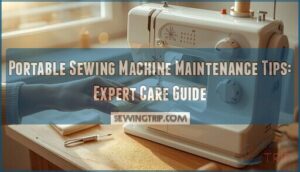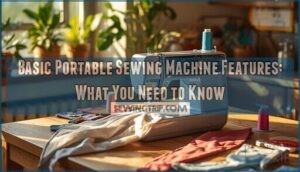This site is supported by our readers. We may earn a commission, at no cost to you, if you purchase through links.
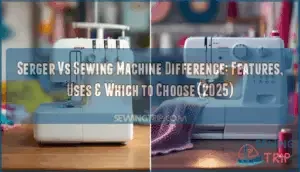
These two workhorses tackle fabric in fundamentally different ways—one builds seams from scratch while the other wraps edges with surgical precision. The serger vs sewing machine difference comes down to construction versus finishing, speed versus range, and professional polish versus creative freedom.
Each machine solves specific problems in your sewing workflow, and understanding their core mechanics helps you choose the right tool for your projects without wasting money on features you’ll never use.
Table Of Contents
Key Takeaways
- Sergers excel at fast edge finishing and stretch fabrics by simultaneously trimming and stitching at 1,300-1,500 stitches per minute, while sewing machines offer versatility for garment construction, decorative work, and precision techniques like buttonholes and zippers.
- The built-in cutting blade on sergers prevents fabric fraying and creates professional seam finishes in one pass, making them essential for knits and activewear, whereas sewing machines provide the control needed for complex construction and detailed alterations.
- Most sewers eventually need both machines since combining them reduces assembly time by 35% and improves garment longevity by 2.5 times—sergers handle edge finishing while sewing machines manage construction details and topstitching.
- Sergers demand higher maintenance with blade replacements every 6-12 months and complex 3-5 thread paths, while sewing machines prove more beginner-friendly with simpler threading and broader project adaptability despite similar entry-level pricing of $150-$300.
Serger Vs Sewing Machine: Core Differences
When you line up a serger next to a sewing machine, the contrasts come into focus fast. From how they’re built to the way they work with fabric, their core differences shape what each can do for you.
Let’s take a closer look at what truly sets these two apart.
Design and Construction
When you look under the hood of a serger and a sewing machine, you’ll notice each one is built with a different mission in mind. Sergers focus on professional seam finishes, using a dedicated blade mechanism for clean edges and a differential feed for stretchy fabric construction. Sewing machines, meanwhile, offer flexibility for garment construction and excel in fabric control and selection.
| Feature | Serger |
|---|---|
| Stitch Formation | Overlock, for seam durability |
| Blade Mechanism | Built-in, trims fabric as you sew |
| Thread Tension | Individually adjustable for each thread |
| Differential Feed | Controls fabric stretch and pucker |
| Machine Weight | Heavier due to extra cutting and threading parts |
Number of Threads and Stitch Types
After understanding how these machines are built for their unique tasks, let’s talk about the threads and stitches each one can pull off. Sergers work with 3-thread or 4-thread setups for strong, professional seams, accommodating overlock variations and chainstitch use. Standard sewing machines deliver greater stitch variety, offering straight, zigzag, and decorative options—all with just one or two threads.
| Feature | Serger |
|---|---|
| Thread Count | 3-5 threads per seam |
| Stitch Variety | Overlock, chainstitch, coverstitch |
| Decorative Options | Limited, basic edge trims |
| Overlock Variations | Strong focus, style flexibility |
Cutting Knife and Edge Finishing
All that talk about threads and stitches sets the stage for what really sets sergers apart: their built-in cutting blade trims fabric edges as you sew, leaving behind a neatly finished seam every time. This single step—cutting, stitching, and finishing—protects against fraying, boosts edge durability, and smooths out even tricky curved edges.
A serger’s built-in blade trims, stitches, and finishes fabric edges in one pass, preventing fraying while delivering professional-grade seam durability
Here’s how different methods compare:
| Method | Trims Edge? | Edge Durability |
|---|---|---|
| Serger (cutting knife) | Yes | Excellent |
| Sewing Machine | No | Good |
| Pinking Shears | Manual | Moderate |
| Zigzag Stitch | No | Variable |
| Decorative Edging | Sometimes | Varies |
Speed and Efficiency
When you want to get projects off your table in record time, the speed difference between a serger and a standard sewing machine is hard to ignore. Sergers fly through seams with 1,500 Stitches Per Minute, leaving sewing machines—usually maxing out at 950—in the dust.
Check the practical contrast:
| Machine | Stitches Per Minute |
|---|---|
| Serger | 1,300–1,500 |
| Sewing Machine | 700–950 |
How a Serger Works
If you’ve ever wondered what makes a serger tick, it comes down to how it treats fabric edges in one motion. Understanding its process helps explain those crisp, professional seams you see on store-bought clothes.
Here’s what happens inside a serger when you put it to work.
Overlock Stitch Formation
Ever wondered how your favorite T-shirt holds its seams so tightly together, even after dozens of washes? That’s the handiwork of overlock stitch formation. Using a Looper System, sergers pass multiple threads through fabric edges, adjusting Thread Tension and Stitch Density.
The machine’s Chain Formation creates a strong, flexible seam—ideal for overcasting stitches on knits and wovens alike.
Simultaneous Trimming and Stitching
Although it might seem like magic at first, a serger neatly trims excess fabric and sews your seam at the same time, giving your projects a clean, finished look in one swoop.
Thanks to its built-in cutting knife and controlled blade mechanism types, you get sharp fabric edge control.
Stitching precision impacts both speed and accuracy, depending on material compatibility and how you adjust blade control.
Handling Stretch and Knit Fabrics
Curious how to keep those tricky stretch and knit fabrics from warping or unraveling? Sergers shine here, blending knit fabric tension with smart controls. For best results:
- Use Differential Feed Settings to prevent wavy seams in stretchy materials.
- Try Rolled Hem Finishes for neat, professional edges.
- Experiment with Chainstitch Applications to reinforce seams on knit garments.
How a Sewing Machine Functions
A sewing machine is a multifaceted tool with more tricks up its sleeve than most folks realize. You’re not just limited to straight stitches or basic seams—there’s a lot more you can do.
Let’s run through the main ways sewing machines make your projects shine.
Versatility in Stitch Selection
If you like having options, a sewing machine is your ticket to a whole world of stitches at your fingertips. You can explore a mix of functional stitches, decorative options, and creative applications by simply adjusting settings or switching specialty feet.
Stitch variety isn’t just for looks—it lets you customize stitch density, experiment with patterns, and improve overall stitch quality.
Garment Construction Capabilities
There’s real magic in how a sewing machine shapes flat fabric into something you can actually wear, turning your ideas into clothes that fit and last.
For garment construction, you’ll:
- Reinforce major seams for maximum seam durability
- Tackle a variety of fabric types with ease
- Switch between stretch and woven fabrics effortlessly
- Achieve a professional finish with efficient construction speed
Decorative and Precision Stitching
When you need your stitches to stand out or your details to line up just right, a sewing machine gives you the precision and creative edge to make it happen. From Stitch Embellishments to Decorative Threads, you’ll get access to specialized feet and a huge library of decorative stitches—perfect for adding Intricate Details and achieving consistently high-quality finishes.
| Feature | Benefit |
|---|---|
| Stitch Patterns | Endless creative options |
| Precision Control | Neat, intricate details |
| Decorative Stitches | Professional finishes |
| Specialized Feet | Enhanced stitch quality |
Key Advantages of Sergers
Sergers bring a few important strengths to your sewing toolkit. If you’re curious about what really sets them apart, you’ll want to look at these main advantages.
Here’s what stands out most about serger machines.
Professional Seam Finishes
Nothing says "professional" in sewing quite like the clean, polished seams you get from a serger. Sergers excel at edge neatness and blend right into visible seams, making decorative edging look intentional. They’re the best practice for finishing fabric edges—turning basic seams into true professional sewing finishes.
Seam durability stands out, especially on knits or woven fabrics prone to fraying.
Fast Edge Finishing
Right after giving your seams a polished look, a serger takes speed up a notch by finishing fabric edges in a flash. Fast edge finishing means you’re not just saving minutes—you’re boosting project efficiency.
Here’s how rapid serger work pays off:
- Speed vs. Quality is no trade-off
- Adjusts to fabric compatibility
- Boosts edge durability
- Minimizes thread consumption
- Shines in industrial applications
Preventing Fabric Fraying
After you’ve zipped along those edges at top speed, a serger steps in to keep even the trickiest fabrics from unraveling over time.
Serger stitches wrap raw edges with precision, acting like a security blanket—essential for fray prevention on delicate or stretchy fabric types. That extra barrier boosts seam durability and gives fabric finishing results you won’t get with basic edge finishing alone.
Key Advantages of Sewing Machines
Sewing machines do more than just join fabric—they open up a world of creative options. From basic repairs to building intricate garments, they’re built for flexibility. Here’s what sets them apart.
Project Versatility
Ever wondered what you could accomplish with just one machine at your side? A sewing machine’s project adaptability is tough to beat—think of it as your creative Swiss army knife. You can tackle:
- Quilts, pillow covers, and fabric crafts for any skill level
- Projects requiring various stitch types and fabric compatibility
- Tasks demanding both creative applications and seam durability
Complex Construction Techniques
Even if fabric projects look complicated on the surface, your sewing machine has the tools to manage every precise seam, pleat, and buttonhole you throw its way. It’s built for Pattern Matching, Fabric Manipulation, and Seam Complexity—essential for sophisticated techniques in modern garment construction.
Design Integration becomes second nature, giving you freedom for professional edge finishing without extra hassle.
Ease of Use for Beginners
If you’re new to sewing, a standard sewing machine is your best starting point because it manages the basics with straightforward controls and forgiving learning curves. Unlike sergers, sewing machines won’t intimidate you with complex threading difficulty or maintenance. Here’s why beginners thrive with standard machines:
- Simple threading and setup — Most user manuals walk you through loading thread in minutes, not hours of frustration.
- Beginner projects feel achievable — Straight seams, basic hems, and pillows build confidence without overwhelming complexity.
- Lower maintenance simplicity — You’ll spend time sewing, not troubleshooting mechanical issues or replacing blades.
- Forgiving learning curve — Mistakes are easy to fix, and you’ll master fundamentals before tackling sophisticated techniques.
A sewing machine lets you build real skills without the steep machine threading difficulty that sergers demand.
When to Use Serger Vs Sewing Machine
Now that you understand how sergers and sewing machines work differently, the real question becomes: which one should you actually use for your project? The answer depends on what you’re trying to accomplish, since each machine excels at different tasks.
Let’s look at where each machine does its best work and how you can use them together for professional results.
Best Projects for Sergers
Sergers shine when you’re working with knits, stretchy fabrics, and garments that need a polished, professional edge in a hurry. They’re your best bet for activewear projects where durability and appearance matter, and they excel at finishing quilting edges without fraying. You’ll also appreciate serger embellishments on decorative hems and home decor items that demand that store-bought polish.
| Project Type | Why Sergers Excel | Best Results |
|---|---|---|
| Knit Garments | Work with stretch without puckering | Clean, flexible seams |
| Activewear Projects | Fast edge finishing prevents fraying | Professional appearance |
| Home Decor & Quilting Edges | Multiple thread options add detail | Durable, polished finishes |
Ideal Uses for Sewing Machines
Your sewing machine is where the real craftsmanship happens—it’s the tool that manages everything from basic construction to intricate details that define how a garment actually comes together. Unlike sergers, your sewing machine gives you the control and flexibility needed for complex garment construction, precise alterations, and decorative embroidery work. Whether you’re installing zippers, creating buttonholes, or stitching pleats, a sewing machine’s adaptability shines through on detailed projects that demand accuracy over speed.
| Project Type | Why Sewing Machines Excel | Best Results |
|---|---|---|
| Garment Construction | Manages multiple seam types and techniques | Structured, well-fitted pieces |
| Home Decor Projects | Precise topstitching and decorative options | Polished, details |
| Quilting Projects | Fine control for intricate piecing | Complex, detailed designs |
| Alterations & Embroidery | Exact stitch placement for modifications | Professional-quality adjustments |
Home decor items, quilting projects, and alterations all benefit from your sewing machine’s precision. For beginners, a sewing machine is also more forgiving and easier to master than a serger, making it the natural starting point for learning to sew.
Combining Both Machines for Professional Results
Both machines working together create professional-quality garments that neither can achieve alone. Professional producers use sergers for edge finishing and seam durability, while sewing machines take care of construction details—this dual approach reduces assembly time by 35% and cuts labor costs by 22%. Overlocked edges resist fraying 92% better than single-needle finishes, and combining machines improves garment longevity by 2.5 times. For knit management, sergers prevent distortion while sewing machines stabilize necklines through topstitching. Some models, like the Baby Lock Accolade, offer sophisticated features. Ready-to-wear clothes use this exact method: 89% feature serged inner seams with machine finishing on hems and decorative elements.
| Workflow Stage | Serger Role | Sewing Machine Role | Efficiency Gain | Quality Result |
|---|---|---|---|---|
| Edge Finishing | Trim and overlock simultaneously | Stabilize with topstitching | 50% faster completion | Professional seam quality |
| Knit Fabrics | Manage stretch with differential feed | Reinforce necklines and armholes | 43% less seam slippage | Durable knit garments |
| Garment Assembly | Finish raw edges | Construct complex details | 30–50% project speedup | High-quality finishes |
| Hem Work | Create rolled or decorative edges | Add precision topstitching | Efficient workflow | Polished appearance |
| Production Scale | Execute bulk edge finishing | Take care of customization | 90% less manual trimming | Flexible applications |
Cost, Maintenance, and Buying Considerations
Before you invest in either machine, you’ll want to know what you’re getting into financially and how much upkeep each one demands. The initial price tag is just the beginning—maintenance costs and your specific sewing goals play a big role in making the right choice.
Let’s break down what you can expect to spend and what factors should guide your decision.
Price Comparison
When comparing costs, entry-level sewing machines and sergers both start around $150 to $300, making the initial investment similar. Mid-range pricing runs from $400 to $1,000 for both machine types, though sergers escalate faster when you add features like automatic threading. High-end machines reach $3,000 to $5,000, with specialty sergers exceeding that mark. Brand influence matters—Singer, Brother, JUKI, and Baby Lock shape market pricing.
Value considerations favor sewing machines for all-around use, but a serger investment pays off if you frequently work with knits. Sergers, also known as overlock machines, finish fabric edges.
Maintenance Needs
Keeping either machine running smoothly depends on how often you use it and how complex its internal mechanisms are. Sergers require more attention because threading complexity and blade replacement add extra steps. Machine maintenance tasks include:
- Blade Replacement: Serger cutting knives dull over time and need swapping every 6–12 months
- Threading Complexity: Sergers use 3–5 thread paths, making tension adjustments trickier than sewing machines
- Oiling Frequency: Both machine types need regular lubrication, but sergers demand it more often
- Professional Servicing: Annual tune-ups help with needle selection and thread management for both machine types
Choosing The Right Machine for Your Needs
Once maintenance is under control, focus on the right match. Start by evaluating project complexity and fabric type—sergers manage knits better, while sewing machines tackle zippers and buttonholes.
Budget constraints matter, since sergers average $350–$650 compared to $100–$700 for sewing machines. Your skill level plays a role too; beginners find sewing machines easier to master.
Space availability and project adaptability round out the serger vs. sewing machine comparison when choosing the right sewing machine or serger features and functions.
Frequently Asked Questions (FAQs)
Can sergers sew buttonholes or install zippers?
No serger can manage buttonholes or zippers—that’s sewing machine territory. Sergers lack zipper foot compatibility and buttonhole limitations stem from their overlock design.
For hybrid projects, you’ll need specialized attachments on your sewing machine or alternative techniques combining both machines.
Do I need both machines for home sewing?
Most home sewers thrive with just a sewing machine, especially when starting out. Budget allocation, project complexity, and sewing frequency determine whether you need both.
For casual crafters, one machine manages most tasks, but frequent garment-makers benefit from owning both tools.
Which machine is better for denim and heavy fabrics?
Heavy-duty sewing machines manage denim and thick fabric layers better than sergers. They feature needle strength, machine power, and specialized heavy-duty features designed for seam bulk and multiple fabric layers, guaranteeing denim durability through strong fabric management and selection capabilities.
Can a serger replace a regular sewing machine completely?
A serger can’t completely replace a sewing machine. While functional overlap exists in seam finishing, project limitations emerge—sergers lack buttonhole, zipper, and topstitching capabilities essential for garment construction.
The hybrid approach combining both machines delivers professional results, though skill requirements differ for each tool.
What fabrics work poorly on serger machines?
Slippery satin sliding under the presser foot can spell trouble. Delicate fabrics like chiffon and sheer fabrics often snag in serger blades, while thick materials such as denim jam the mechanism. Coated fabrics and unstable weaves also resist clean cutting and stitching.
Conclusion
You’ll waste more fabric, time, and money if you ignore the serger vs sewing machine difference than you’ll buying the wrong tool. Master when to deploy each machine—sergers for lightning-fast edge finishing and stretch fabrics, sewing machines for construction and creative control—and your projects transform from homemade to handcrafted.
Most sewers eventually need both, but your current skill level and project list determine which one lands on your table first.

